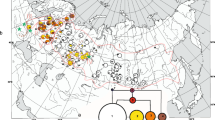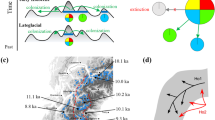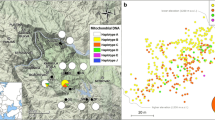Abstract
The Carpathians are a range of mountains forming an arc roughly 1,500 km long across Central and Eastern Europe. They are an important area for biodiversity and belong to one of the major refuges of the last ice ages for many organisms. The forests of the Carpathians are dominated by spruce, which have suffered continuous outbreaks of the eight spined spruce bark beetle, Ips typographus, in recent decades. The phylogeography of this spruce pest is well documented, however, little is known on small scale, i.e., the Carpathians. Here we applied a mitochondrial marker and studied the genetic variation and structure of Carpathian populations and compared data with published one from other European populations. Twelve haplotypes were characterized and 42 % of those were not detected in other European populations. Despite a slight genetic structure, differences were observed in the haplotype distribution and diversity between the Western/Southern Carpathians and the Eastern Carpathians reflecting at least two potential refugial areas for I. typographus within the Carpathian mountain system. Further data show that the Eastern Beskidian Mountains of the Carpathians could act as barrier for several European haplotypes. This small-scale analysis reveals that the Carpathians have been an important glacial and post-glacial refuge for I. typographus. This information is important for a preventive and reactive forest management.


Similar content being viewed by others
References
Avtzis DN, Bertheau C, Stauffer C (2012) What is next in bark beetle phylogeography? Insects 3:453–472
Babik W, Branicki W, Crnobrnja-Isailovic J, Cogalniceanu D, Sas I, Olgun K, Poyarkov NA, Garcia-París M, Arntzen JW (2005) Phylogeography of two European new species-discordance between mtDNA and morphology. Mol Ecol 14:2475–2491
Bertheau C, Krumböck S, Schuler H, Arthofer W, Stauffer C (2011) Hit or miss in phylogeographic analyses: the case of the cryptic NUMTs. Mol Ecol Resour 11:1056–1059
Bertheau C, Schuler H, Arthofer W, Avtzis D, Mayer F, Krumböck S, Moodley Y, Stauffer C (2013) Divergent evolutionary histories of two sympatric spruce bark beetle species. Mol Ecol. doi:10.1111/mec.12296
Botterweg PF (1982) Dispersal and flight behaviour of the spruce bark beetle Ips typographus in relation to sex, size and fat content. Z Angew Entomol 94:466–489
Clement M, Posada D, Crandall K (2000) TCS: a computer program to estimate gene genealogies. Mol Ecol 9:1657–1660
Conord C, Lempérière G, Taberlet P, Després L (2006) Genetic structure of the forest pest Hylobius abietis on conifer plantations at different spatial scales in Europe. Heredity 97:46–55
Duelli P, Zahradnik P, Knizek M, Kalinova B (1997) Migration in spruce bark beetles (Ips typographus L.) and the efficiency of pheromone traps. J Appl Entomol 121:297–303
Excoffier L, Laval G, Schneider S (2005) Arlequin (version 3.0) an integrated software package for population genetics data analysis. Evol Bioinform 1:47–50
Excoffier L, Smouse PE, Quattro JM (1992) Analysis of molecular variance inferred from metric distances among DNA haplotypes: application to human mitochondrial DNA restriction data. Genetics 131:479–491
Faccoli M, Stergulc F (2004) Ips typographus (L.) pheromone trapping in south Alps: spring catches determine damage thresholds. J Appl Entomol 128:307–311
Felsenstein J (1988) Phylogenies from molecular sequences: inference and reliability. Annu Rev Genet 22:521–565
Forsse E, Solbreck C (1985) Migration in the bark beetle Ips typographus L.: duration timing and height of flight. Z Angew Entomol 100:47–57
Grégoire JC, Evans H (2004) Damage and control of BAWBILT organisms: an overview. In: Lieutier F et al (eds) Bark and wood boring insects in living trees in Europe, a synthesis. Kluwer, Dordrecht, pp 19–37
Gries G (1985) Zur Frage der Dispersion des Buchdruckers (Ips typographus L.). Z Angew Entomol 99:12–20
Gurung AB, Bokwa A, Chełmicki W, Elbakidze M, Hirschmugl M, Hostert P et al (2009) Global change research in the Carpathian mountain region. Mt Res Dev 29:282–288
Hall TA (1999) BioEdit: a user-friendly biological sequence alignment editor and analysis program for Windows 95/98/NT. Nucl Acid 41:95–98
Hasegawa M, Kishino H, Yano TA (1985) Dating of the human–ape splitting by a molecular clock of mitochondrial DNA. J Mol Evol 22:160–174
Jaarola M, Searle JB (2002) Phylogeography of field voles (Microtus agrestis) in Eurasia inferred from mitochondrial DNA sequences. Mol Ecol 11:2613–2621
Jakus R, Zajíčkova L, Cudlín P, Blaženec M, Turčani M, Ježík M, Lieutier F, Schlyter F (2011) Landscape-scale Ips typographus attack dynamics: from monitoring plots to GIS-based disturbance models. Forest 4:256–261
Juan C, Oromi P, Hewitt GM (1995) Mitochondrial DNA phylogeny and sequential colonization of Canary Islands by darkling beetles of the genus Pimelia (Tenebrionidae). Proc R Soc Lond B Biol Sci 261:173–180
King RA, Ferris C (1998) Chloroplast DNA phylogeography of Alnus glutinosa (L.) Gaertn. Mol Ecol 7:1151–1161
Kotlik P, Deffontaine V, Mascheretti S, Zima J, Michaux JR, Searle JB (2006) A northern glacial refugium for bank voles (Clethrionomys glareolus). Proc Natl Acad Sci U S A 103:1860–1864
Lieutier F (2002) Mechanisms of resistance in conifers and bark beetle attack strategies. In: Wagner MR, Clancy KM, Lieutier F, Paine TD (eds) Mechanisms and deployment of resistance in trees to insects. Kluwer Academic Publishers, Dordrecht, pp 31–77
Lieutier F, Day KR, Battisti A, Grégoire JC, Evans HF (2004) Bark and wood boring insects in living trees in Europe, a synthesis. Kluwer Academic Publishers, Dordrecht
Lunt D, Zhang DX, Szymura JM, Hewit GM (1996) The insect COI gene: evolutionary patterns and conserved primers for phylogenetic studies. Insect Mol Biol 5:153–165
Magri D, Vendramin GG, Comps B, Dupanloup I, Geburek T, Gomory D et al (2006) A new scenario for the Quaternary history of European beech populations: palaeobotanical evidence and genetic consequences. New Phytol 171:199–221
Mardulyn P, Mikhailov YE, Pasteels JM (2009) Testing phylogeographic hypotheses in a Euro-Siberian cold-adapted leaf beetle with coalescent simulations. Evolution 63:2717–2729
McCarthy C (1996) Chromas ver. 1.45. School of Health Science, Griffith University, Southport
Mraz P, Gaudeul M, Rioux D, Gielly L, Choler P, Taberlet P (2007) Genetic structure of Hypochaeris uniflora (Asteraceae) suggests vicariance in the Carpathians and rapid post-glacial colonization of the Alps from an eastern Alpine refugium. J Biogeogr 34:2100–2114
Pauls SU, Lumbsch HT, Haase P (2006) Phylogeography of the montane caddisfly Drusus discolor: evidence for multiple refugia and periglacial survival. Mol Ecol 15:2153–2169
Pecskay Z, Lexa J, Szakacs A, Seghedi I, Balogh K, Konecny V et al (2006) Geochronology of Neogene magmatism in the Carpathian arc and intra-Carpathian area. Geol Carpath 57:511–530
Peterson MA, Denno RF (1998) The influence of dispersal and diet breadth on patterns of genetic isolation by distance in phytophagous insects. Am Nat 152:428–446
Petit R, El Mousadik A, Pons O (1998) Identifying populations for conservation on the basis of genetic markers. Conserv Biol 12:844–855
Pons O, Petit RJ (1996) Measuring and testing genetic differentiation with ordered versus unordered alleles. Genetics 144:1237–1245
Posada D, Crandall KA (1998) MODELTEST: testing the model of DNA substitution. Bioinformatics 14:817–818
Ronikier M, Cieślak E, Korbecka G (2008) High genetic differentiation in the Alpine plant Campanula alpina: evidence for glacial survival in several Carpathian regions and long-term isolation between the Carpathians and the Eastern Alps. Mol Ecol 17:1763–1775
Ruffini VF, Streifeneder T, Eiselt B (2006) Implementing an international mountain convention, an approach for the delimitation of the Carpathian Convention area. Eurac-research and United Nations Environment Programme—Vienna Interim Secretariat of the Carpathian Convention UNEP Vienna—ISCC
Sallé A, Kerdelhué C, Breton M, Lieutier F (2003) Characterization of microsatellite loci in the spruce bark beetle Ips typographus (Coleoptera: Scolytinae). Mol Ecol Notes 3:336–337
Sallé A, Arthofer W, Lieutier F, Stauffer C, Kerdelhué C (2007) Phylogeography of a host-specific insect: genetic structure of Ips typographus in Europe does not reflect past fragmentation of its host. Biol J Linn Soc 90:239–246
Schmidt-Vogt H (1977) Die Fichte. Verlag Paul Parey, Hamburg
Schmitt T (2009) Biogeographical and evolutionary importance of the European high mountain systems. Front Zool 6:9
Schmitt T, Seitz A (2001) Intraspecific allozymatic differentiation reveals the glacial refugia and the postglacial expansions of European Erebia medusa (Lepidoptera: Nymphalidae). Biol J Linn Soc 74:429–458
Sommer RS, Benecke N (2005) The recolonization of Europe by brown bears Ursus arctos linnaeus, 1758 after the last glacial maximum. Mammal Rev 35:156–164
Stauffer C, Lakatos F, Hewitt GM (1999) Phylogeography and postglacial colonization routes of Ips typographus L. (Col.: Scolytidae). Mol Ecol 8:763–773
Stenseth NC, Kirkendall LR (1989) Population dynamics of bark beetles with special reference to Ips typographus. Holarctic Ecol 12:382–383
Stoeckle BC, Kuehn R (2011) Identification of 18 polymorphic microsatellite loci in the spruce bark beetle Ips typographus L. (Coleoptera: Scolytidae) using high-throughput sequence data. Eur J Entomol 108:169–171
Swofford DL (2002) PAUP*: phylogenetic analysis using parsimony (*and other methods). Sinauer Associates, Sunderland
Thompson JD, Higgins DG, Gibson TJ (1994) ClustalW: improving the sensitivity of progressive multiple sequence alignment through sequence weighting, positions-specific gap penalties and weight matrix choice. Nucl Acid Res 22:4673–4680
Tollefsrud MM, Kissling R, Gugerli F, Johnsen Ø, Skrøppa T, Cheddadi R et al (2008) Genetic consequences of glacial survival and postglacial colonization in Norway spruce: combined analysis of mitochondrial DNA and fossil pollen. Mol Ecol 17:4134–4150
Ursenbacher S, Carlsson M, Helfer V, Tegelström H, Fumagalli L (2006) Phylogeography and Pleistocene refugia of the adder (Vipera berus) as inferred from mitochondrial DNA sequence data. Mol Ecol 15:3425–3437
Vos P, Hogers R, Bleeker M, Reijans M, Van de Lee T, Hornes M et al (1995) AFLP: a new technique for DNA fingerprinting. Nucl Acids Res 23:4407–4414
Wermelinger B (2004) Ecology and management of the spruce bark beetle Ips typographus-a review of recent research. Forest Ecol Manag 202:67–82
Weslien J, Lindelow A (1990) Recapture of marked spruce bark beetles (Ips typographus) in pheromone traps using area-wide mass trapping. Can J For Res 20:1786–1790
Zhang DX, Hewitt GM (1996) Nuclear integrations: challenges for mitochondrial DNA markers. Trends Ecol Evol 11:247–251
Acknowledgments
This study is part of the PhD thesis of E. Krascsenitsová funded by the Operational Program of Research and Development. This project was funded by the European Fund for Regional Development (EFRD); by the Austrian Exchange Programme Aktion Österreich—Slowakei—Grant: ITMS 26220220087: The development of ecological methods to control chosen forest pests in vulnerable mountainous regions of Slovakia; by the Austrian Science Foundation FWF P21147-B17; and by the European Union Seventh Framework Programme FP7 2007–2013 (KBBE 2009-3) under grant agreement 245268 ISEFOR. We are grateful to Ján Kohout, Fedor Čiampor, Ivana Daubnerová, Veronika Michalková for their assistance in data analysis, Alena Šedivá, Susanne Krumböck, Anna Macková for their technical help, Leonard J. Beans for correcting the language and the three anonymous referees for their comments on earlier draft of the manuscript.
Author information
Authors and Affiliations
Corresponding author
Additional information
Communicated by M. Traugott.
Rights and permissions
About this article
Cite this article
Krascsenitsová, E., Kozánek, M., Ferenčík, J. et al. Impact of the Carpathians on the genetic structure of the spruce bark beetle Ips typographus . J Pest Sci 86, 669–676 (2013). https://doi.org/10.1007/s10340-013-0508-8
Received:
Accepted:
Published:
Issue Date:
DOI: https://doi.org/10.1007/s10340-013-0508-8




